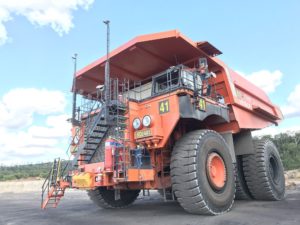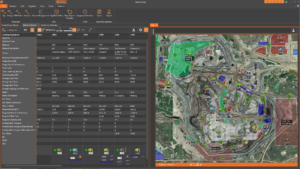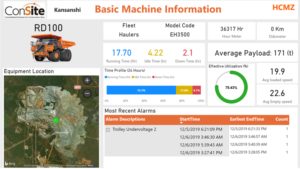The future of autonomy in mining is set to include much more open and interoperable platforms than exist today. And the evolution of fleet management systems or FMS as they are known in the industry is a key part of that – enabling mining customers to get the elusive “single source of the truth” across the on the ground reality of mixed fleets and contractor machines. Ahead of an in-depth article on the future of FMS in the May 2021 edition of IM, Editorial Director Paul Moore caught up with Wenco’s Reid Given, Senior Product Manager & Patrick Ligthart, Principal Product Manager to explore the topic of Open Autonomy and where the latest FMS functionality
Q How important is the FMS system to achieving true open autonomy and how has your open autonomy approach been received so far by the mining industry?
RG FMS is only one component in achieving Open Autonomy. What’s more important for Open Autonomy than any individual component is establishing open standards that break down the current closed approach and, instead, allow customers to mix and match components from their preferred vendors. This way, customers can choose technologies that drive the best ROI for them in their unique circumstances — the most efficient trucks, the smartest and safest autonomous drivers, the FMS most tightly integrated with their systems and processes, and so on. Now that we’ve introduced this vision of Open Autonomy, it’s gathering a lot of momentum. Wenco and other industry contributors are making progress on ISO 23275 and proposing new standards for other components. We’re also working with several customers and industry thought leaders to bring the Open Autonomy approach commercially to market. Non-traditional mining OEMs are especially excited about the prospects of Open Autonomy, as it gives them a path to enter our market. Open Autonomy enables new mining strategies to become profitable, such as swarm mining — a tactic that uses trucks previously considered too small for our industry. As a result, we’re being engaged by companies from the automotive, long-distance trucking, and military industries looking to apply their autonomy technologies to mining use cases.

Q Is FMS interoperability still an issue in mining in enabling mines to access the technologies that they want to use; what progress is Wenco making in this regard?
PL Interoperability can still prove a challenge when mines rely on critical technologies that remain siloed. Without the ability to exchange data freely between their operational systems, mines struggle to optimise their decision-making — that is, have the right decisions made at the right time by the right person. Mines typically have vast volumes of data to support these decisions, but they’re not treating their operational data as the asset it is. Too much data is left untapped in huge databases with only limited connection to other systems — at best. Wenco has always taken care to make our database as accessible as possible, allowing mines to turn their data into actionable intelligence with the least amount of overhead. We’re continuing to expand our capabilities in this area with our own technologies and with other vendors in the pit-to-port landscape. We currently have projects working to integrate solutions from various OEMs and aftermarket vendors that enforce stricter material compliance, facilitate ISA-95 automation, and strengthen management of unexpected events using cameras and other sensors. All these projects are aimed at extending our interoperability with others to help mining customers extract more unrealised value.
Q Automation aside, what role do today’s FMS systems in enabling highest levels of mining efficiency such as high precision and asset health systems?
RG The real power of any data system comes from its improved decisions. FMS and other operational mine technologies deliver greater control, yes, but they also create synergies and enable more robust insights than are possible otherwise. The contextual data about equipment behaviour that comes from an FMS allows these other technologies to make much more accurate decisions around ore/waste determination (and, therefore, enable selective mining) and predictive maintenance. It works both ways as well. With the FMS serving as the orchestrator for in-pit operations, data from high-precision and asset health systems gives dispatchers and mine controllers the ability to act on deviations that occur within a shift. For example, access to messages and events from third-party systems allows our FMS to make smarter assignments, such as diverting a truck that was in the process of being loaded when a ground-engaging tool alarm was generated away from the crusher.

Q What potential is there in teaming Wenco’s FMS technology with Hitachi tech such as ConSite to achieve best results for customers?
PL Wenco is creating ConSite Mine for Hitachi Construction Machinery (HCM) on a digital IoT platform, to be delivered this year, with the intention of integrating Wenco, HCM, and third-party technologies into solutions that deliver the best results for customers. Of course, this platform will ultimately integrate Wenco FMS capabilities with advanced technologies from Hitachi and other ecosystem partners. The digital IoT platform being created by Wenco on behalf of HCM is designed to serve as a one-stop shop for capture, storage, processing, exchange, and analysis of data through an open architecture and with common interfaces. This digital IoT platform is not only intended for our current customer base of Tier 1 and Tier 2 mines, but also for customers in markets such as quarries, construction, and beyond who understand the efficiency gains possible from digital technologies. There is huge demand from these sectors for an integrated, cloud-based fleet management solution that isn’t tied to a specific location. This platform will be able to deliver certain cross-functionalities that are difficult to establish with single purpose on-premises technologies, while also bringing capabilities normally reserved for top-tier mining companies to a whole new series of customers. It also offers new ways to scale and manage FMS functions in a much more tailored way, so our customers can invest discretely in solutions that really drive their operation forward.

Q How can long term existing Wenco FMS customers benefit from the latest functionalities – how easy is it for them to “upgrade” or is it effectively like putting in an entirely new system?
RG We’re very careful about ensuring our long-term customers can take advantage of our latest functionalities. It’s top of mind for us as we build our new solutions, including our digital IoT platform. Our philosophy is to make the transition to our new platform as seamless as possible as we gradually release new capabilities. We know the impact a hardware replacement can have on our customers, so we’re very careful about designing our technology to avoid cases where a hardware upgrade is required to derive optimal value. We obviously strive to avoid the change management requirements that come when a new solution is implemented. As such, our pathway to a new platform is much more evolutionary, rather than revolutionary.











